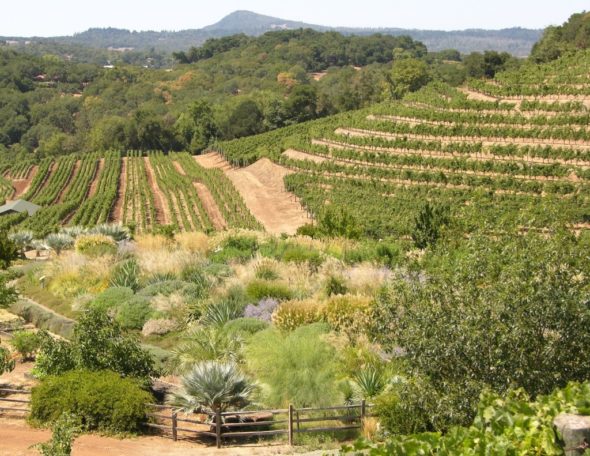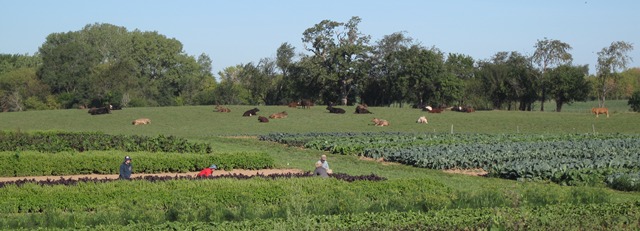
Rebecca Briggs, Communications Coordinator at the Biodynamic Association
Rebecca Briggs is the Communications Coordinator at the Biodynamic Association, a nonprofit group of individuals and organizations who are committed to rethinking agriculture through healthy food, healthy soil, and healthy farms. The Biodynamic Association was started in 1938 and is considered one of the oldest sustainable agriculture organizations in North America. Based on the teachings of Austrian educator Rudolph Steiner, biodynamics is an approach to organic agriculture that views nature as a living, self-sustaining organism in which material, biological, and spiritual elements are united. Biodynamic methods are designed to stimulate and sustain the farm’s inherent fertility, health and terroir through the integration of crops and livestock, the restoration of on-farm biodiversity, and thoughtful cooperation with the influence of the sun, moon and planets on the Earth. I reached Rebecca at her home in Eugene, Oregon, to talk about her work.
Sasha: How did you first become interested in the biodynamic movement?
During the summer after my first year in an environmental studies masters program, I got connected with a small biodynamic farm in the area through a friend in the grad program. Working on the farm really changed everything for me. It became so clear that food and agriculture were where I wanted to focus my studies and career. I didn’t get very deep into biodynamics at that time, but felt such a huge respect for the farmers and their ideals, and I fell in love with the diversity and beauty of that farm. They were members of the Biodynamic Association, and when a position opened to edit the Biodynamics journal, they suggested I apply. So I really learned a lot on the job. (And continue to do so!)
Sasha: Biodynamic farming has an important spiritual element to it. What influence has your academic background in religion had on your interest in biodynamic farming?
I’m not sure if my background influences my interest in biodynamics so much as it derives from the same foundations. I’ve always wanted to figure out how the world works (spiritually, philosophically, politically, etc), which is a major reason I was interested in religious studies. I feel like biodynamics is a really holistic way of approaching some of the same fundamental questions.
Sasha: I see a growing number of biodynamic wines on the grocery store shelves these days. What has spurred this growth in the wine industry in particular? Are there other biodynamic products we can expect to see on supermarket shelves in the near future?
There are probably a lot of factors involved in that growth, but I get the sense a lot winemakers have experienced how Biodynamic® wines often have a different quality and vitality, and they’ve wanted to go in that direction. I think both wine makers and wine consumers tend to be very sensitized to quality, so they detect the differences in Biodynamic wines. And many also want to farm in a better, more holistic way. When you tour some of the Biodynamic vineyards, the difference compared to a conventional, sterile-seeming wine grape monoculture is just amazing – the diversity of plant life, the beauty of the flowering cover crops, the integration of animals, the protection of pollinators and natural areas, etc.
I think as more consumers become aware of biodynamics, the more viable the transition becomes for all sorts of growers, and the momentum will build. There are already more Biodynamic® products available, thanks to recent efforts by Demeter USA (the Biodynamic certifier in the U.S.) and Whole Foods to transition more farms. I think we’ll be a seeing a lot more as public understanding and desire for them continues to grow.

Benzinger Winery. Courtesy BDA
Sasha: California is experiencing its fourth year of severe drought. How has the biodynamic farming community there responded to this challenge?
Some Biodynamic wineries and farms in California have been implementing creative water conservation and recycling strategies for a number of years, so there is a lot to learn from them – Benzinger Winery and Filigreen Farm, for example. In general, we try to take the good work of our members and make it available for others to learn from.
We’re expecting that drought and farming in arid climates will be a big issue for discussion and learning at our next North American Biodynamic Conference in Santa Fe in the fall of 2016. There’s been significant research on and experience with biodynamics in drought conditions in Australia, which I think we can learn a lot from. There is also research to suggest that the biodynamic preparations help a farm balance itself and maintain more consistent yields during years of extreme weather. I’m sure we’ll be discussing all this and more at our conference.
Sasha: Has the rapid advance in technology over the past 10 years had any significant effect on the biodynamic movement, and on the Biodynamic Association in particular?
It’s been a massive change for both the movement and our organization. Ten years ago, printed materials were the sole form of education and knowledge sharing, aside from learning in person at regional events or farms. The BDA has always played a key role in helping to disseminate information across the continent, but technology advances allow us to do much, much more in that regard, and much more quickly. The same goes for other organizations in the movement. For example, we keep adding more online resources and information, we recently started hosting webinars, and we’re connected with the worldwide movement through social networks. Technology has also changed how we can operate as an organization: nearly half our staff are on the west coast, with the rest in Wisconsin, and members of our board and advisory committees are located across the U.S. and Canada. Nonetheless, we do try to stay aware that technology is just a tool, and we try to keep an appropriate balance in that regard.
I think you can say the same for our members. Many certainly make a lot of use of modern technology, like solar-powered and even GPS-guided tractors. But I think they recognize that there’s something at the heart of biodynamics that’s very different: a life force, a reverence and respect for nature.
Sasha: Do you practice biodynamic farming at home?
I live in town, so I garden. I try to do as much as I can with the space I have, but it’s always a work in progress. I’m really interested in how biodynamics applies in the urban context. For example, how can we talk about the biodynamic “farm organism” in a small garden? How can you incorporate animal life in a very small space? There’s a lot of great discussion starting to happen around this topic.
Sasha: What are some of BDA’s top hopes and goals for the next generation of biodynamic farmers?
We’re seeing so much amazing energy, enthusiasm, and creativity in the next generation. Specifically in biodynamics, we’re seeing young farmers who want to move beyond simply not using chemicals to something more meaningful and holistic, with deeper ideals. So we’re doing our best to meet this by providing educational programs, financial support, and ways for them to connect with each other. They’re already becoming leaders and educators within the movement and are affecting the dynamics and future direction. I think we’re really just trying to support and foster this positive impulse that already exists.

A biodynamic farm at work. Courtesy BDA